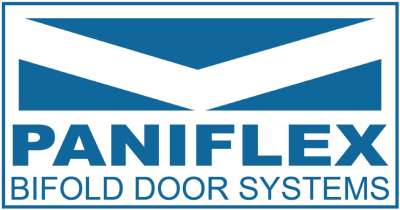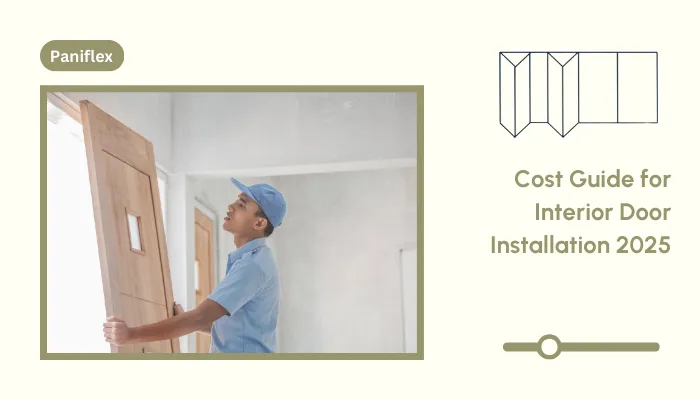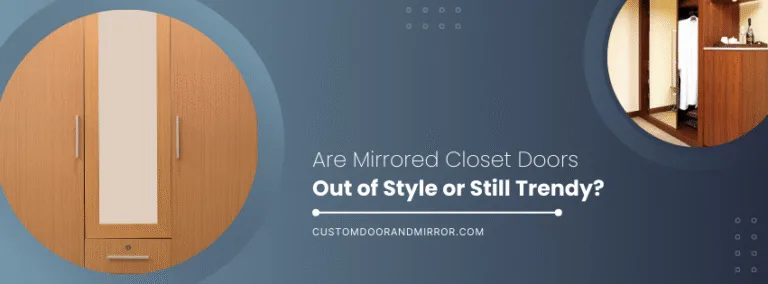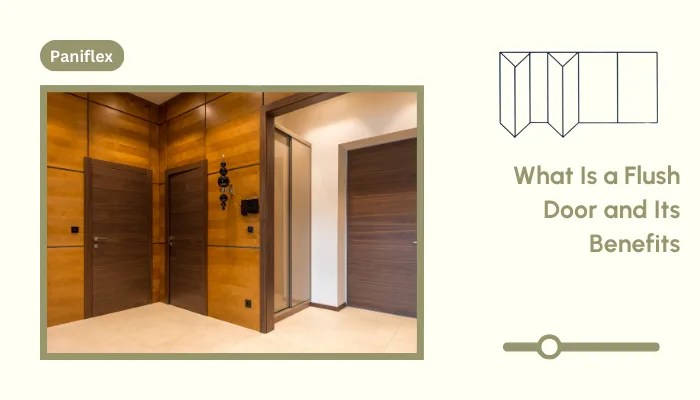Interior doors do more than separate spaces—they influence a room’s aesthetics, functionality, and acoustics. Whether you are upgrading an office space or renovating a home, the cost of installing interior doors depends on multiple factors.
Without a clear understanding of these variables, expenses can quickly add up, making budgeting a challenge.
This guide breaks down the key cost components, helping you make informed decisions based on your needs and budget. You will gain insights into the price differences between door types, material options, labor expenses, and additional costs that often go unnoticed.
By the end, you will have a complete understanding of what to expect when planning for interior door installation in 2025.
Ready to experience the benefits of custom closet doors? Explore our range of Paniflex products now.
Key Factors Affecting Interior Door Installation Costs
Multiple factors influence the cost of installing an interior door. Understanding these variables can help you plan your budget more effectively and avoid unexpected expenses.
Without proper planning, the cost of installation can quickly exceed expectations. Below are the key elements that impact pricing:
Door Type
Different types of interior doors come with varying price points based on their design and complexity. Standard hinged doors are often the most affordable, while options like pocket, barn, or bifold doors require specialized hardware and installation techniques, increasing costs.
Material Choices
The material of a door significantly affects its price and durability. Solid wood doors offer a premium look and feel but are more expensive. MDF and composite doors provide a budget-friendly alternative with decent durability, while glass or mirrored doors add a modern aesthetic but require careful handling and installation.
Size and Customization
Standard door sizes are more affordable, whereas custom-sized doors require precision manufacturing, leading to higher costs. Additional design elements like paneling, inlays, or specialty finishes can also increase expenses.
Labor Costs
Labor costs can vary depending on the region, the complexity of the project, and the installer’s expertise. However, a straightforward door replacement costs less than installing a pocket door that requires cutting into a wall.
Additional Costs
Beyond the door itself, there are extra costs to consider. Frames, hinges, locks, and handles contribute to the total installation price, and modifying the existing door frame can increase labor and material expenses.
Understanding these factors can help you estimate costs more accurately. Whether you are selecting a single door for an office or upgrading multiple doors for a large project, knowing what to expect financially will help you plan ahead.
The next section will explore the cost breakdown for different door types.
Cost Breakdown by Door Type
The type of interior door you choose significantly impacts the overall installation cost. Some doors require simple hardware and minimal labor, while others involve complex installation techniques, increasing expenses.
Below is a breakdown of the costs associated with different interior door types.
Hinged Doors
Hinged doors are the most common type, featuring a traditional swing mechanism attached to a door frame with hinges. They are available in various materials, from budget-friendly MDF to premium solid wood, influencing their overall cost.
Installation is relatively straightforward, making them one of the most affordable options.
- Cost Range: $100 – $500 per door (including installation)
- Factors Affecting Cost: Material choice, frame adjustments, and hardware selection.
- Installation Complexity: Low. It requires standard installation with minimal labor costs.
A hinged door is a great choice if you are looking for a simple, functional, and cost-effective option. However, if you need a space-saving solution, consider a bifold door instead.
Bifold Doors
Bifold doors consist of two or more panels that fold against each other when opened. They are commonly used for closets, pantries, and laundry rooms, providing accessibility while minimizing the space required for door clearance.
The cost of bifold doors varies based on material, width, and the quality of the track system.
- Cost Range: $150 – $700 per door
- Factors Affecting Cost: Track system quality, door material, and width.
- Installation Complexity: Moderate. It requires proper track alignment and balance.
Bifold doors are an excellent space-saving alternative to hinged doors. However, sliding doors may be the better option for a more seamless and modern aesthetic.
Sliding Doors
Sliding doors move along a track rather than swinging open, making them ideal for modern interiors, closets, and room dividers. They come in various materials, including mirrored, frosted glass, and wooden panels.
The cost depends on the quality of the track, panel material, and the complexity of the installation.
- Cost Range: $300 – $1,000 per door
- Factors Affecting Cost: Glass panel options, track durability, and installation area.
- Installation Complexity: Moderate. Precise track installation is required for smooth operation.
Sliding doors offer a sleek, contemporary look but require careful track alignment for smooth operation. If you need an even more space-efficient solution, pocket doors might be worth considering.
Pocket Doors
Pocket doors slide into a concealed cavity within the wall, maximizing space efficiency. Since they require cutting into the wall and installing a track inside, the installation process is more complex than that of sliding doors.
This added complexity increases the overall cost.
- Cost Range: $500 – $1,500 per door
- Factors Affecting Cost: Wall modification, track system, and door material.
- Installation Complexity: High. It requires wall opening adjustments and precise alignment.
Pocket doors are perfect for small rooms where a swinging door would be impractical. However, French doors may be a better fit if you are looking for a more decorative and sophisticated option.
French Doors
French doors are double doors with glass panels that create an open and elegant look. They are commonly used in home offices, dining rooms, and other spaces where aesthetics matter. The price varies depending on the type of glass, frame material, and hinge quality.
- Cost Range: $400 – $2,000 per pair
- Factors Affecting Cost: Glass type, frame material, and hinge quality.
- Installation Complexity: Moderate to high. It requires precise door alignment and reinforced framing.
French doors enhance the flow of natural light and add a touch of sophistication to any space. Barn doors might be a better option if you prefer a rustic or industrial feel.
Barn Doors
Barn doors slide along an exposed track system, offering a distinctive, rustic look. They are commonly used to create a statement piece in residential and commercial spaces. The cost varies based on track material, door size, and mounting surface.
- Cost Range: $300 – $1,500 per door
- Factors Affecting Cost: Track style, material, and mounting surface.
- Installation Complexity: Moderate. It requires strong wall anchoring and level track installation.
Barn doors provide a bold design element but require a strong wall structure for proper mounting. The level of customization, hardware quality, and installation complexity all affect the final expense.
Carefully assessing your space, needs, and budget will help you choose the right door without overspending.
Now that we have explored how door type affects pricing, the next step is understanding how different materials influence cost and durability.
Suggested Watch: This video can help you understand what to expect when budgeting for your project. It provides a quick overview of pricing factors, including labor, materials, and hidden expenses.
Material Cost Comparison
The material of an interior door plays a crucial role in its price and durability. While some materials offer a premium look and feel, others provide cost-effective solutions without compromising functionality.
Selecting the right material balances budget, aesthetics, and long-term maintenance. Below is a breakdown of the most common door materials and their associated costs.
Solid Wood
Solid wood doors are known for their durability, natural beauty, and excellent sound insulation. They are often chosen for high-end residential and office spaces where aesthetics and quality matter. However, their cost varies based on the type of wood used.
- Cost Range: $250 – $2,000 per door
- Pros: High durability, rich appearance, excellent sound insulation
- Cons: Expensive, susceptible to warping in humid environments
- Best For: Luxury interiors, traditional and classic designs
Solid wood doors provide a timeless and premium look but require careful maintenance. If budget constraints are a concern, MDF doors offer a similar aesthetic at a lower cost.
MDF and Composite
Medium-density fiberboard (MDF) and composite doors are engineered wood alternatives that provide affordability without sacrificing style. They can be finished to mimic the appearance of solid wood but at a fraction of the cost.
- Cost Range: $100 – $600 per door
- Pros: Cost-effective, smooth surface for painting, resistant to warping
- Cons: Less durable than solid wood, not moisture-resistant unless treated
- Best For: Budget-friendly projects, modern interiors, painted finishes
MDF doors offer a practical solution for cost-conscious buyers, but for a sleek, modern aesthetic, glass or mirrored doors might be a better fit.
Glass and Mirrored Doors
Whether frosted, clear or mirrored, glass doors add a contemporary touch and allow natural light to pass through. They are commonly used in offices, modern homes, and closet spaces.
- Cost Range: $300 – $1,500 per door
- Pros: Enhances light flow, stylish, available in various designs
- Cons: Prone to fingerprints and smudges, requires careful handling
- Best For: Modern interiors, offices, spaces needing additional light
Glass doors elevate a space’s design, but metal doors may be a better choice if durability is a top priority.
Metal Doors
Metal interior doors are less common but are often used in industrial-style interiors or areas that require extra durability and security. They are often made from aluminum or steel and come in various finishes.
- Cost Range: $200 – $1,000 per door
- Pros: Highly durable, low maintenance, fire-resistant options available
- Cons: Limited design flexibility, can be heavy
- Best For: Industrial-style interiors, high-traffic areas
Each material offers distinct advantages, and the right choice depends on your budget and design priorities.
Once you have decided on the door material, labor and installation costs are the next critical factor to consider. Let us explore how professional installation, DIY options, and regional pricing impact your total expense.
From the Community: Check out this discussion for a more detailed perspective on interior door replacement costs in today’s market. With labor and material prices fluctuating post-2020, remodelers and trim carpenters share their insights on pricing strategies and cost challenges.
Labor and Installation Costs
Labor charges can make up a significant portion of the total expense beyond the door’s cost. The complexity of installation, regional pricing variations, and whether professional services or a DIY approach are used all affect the final cost.
Understanding these factors can help property owners budget accurately and avoid unexpected expenses.
Professional Installation Rates
Hiring a professional ensures precise installation, proper alignment, and long-term functionality. However, labor costs vary depending on the complexity of the job and the installer’s expertise.
- Basic Hinged Door Installation: $100 – $300 per door
- Bifold or Sliding Door Installation: $200 – $600 per door
- Pocket Door Installation: $400 – $1,200 per door (due to wall modifications)
- French or Barn Door Installation: $250 – $800 per door
Professionals typically charge either a flat fee per door or an hourly rate, which can range from $50 to $150 per hour, depending on location and project scope.
DIY vs. Professional Installation
While DIY installation can reduce costs, it is not always the best option—especially for complex doors like pocket or sliding models. Below are the key considerations:
- DIY Installation Costs: Limited to tools and materials ($50 – $200)
- Challenges: Misalignment, improper track installation, potential damage to walls
- Best for: Simple hinged doors or minor replacements
- Not recommended for pocket doors, barn doors, or custom-sized installations
Professional installation is worth the investment if precision and long-term durability are priorities. However, regional labor costs can still affect final pricing.
Regional Variations in Labor Costs
Labor costs vary significantly based on location, with urban areas generally having higher rates due to demand and cost of living. Below is an approximate range:
- Low-Cost Regions (Rural & Small Towns): $50 – $100 per hour
- Mid-Range Regions (Suburban Areas): $75 – $125 per hour
- High-Cost Regions (Major Cities): $100 – $150+ per hour
Choosing local contractors or comparing multiple quotes can help property owners find the best pricing for the area.
Properly accounting for labor costs ensures an accurate project budget. However, installation expenses do not stop at labor—hidden costs, such as frame modifications and hardware, can add up quickly.
In the next section, we will explore these additional expenses to help you prepare for the full scope of interior door installation costs.
Hidden Costs and Additional Expenses
Beyond the door and installation fees, several additional costs can impact your total budget. These hidden expenses often catch buyers off guard, making it essential to factor them into your planning.
From structural modifications to hardware and finishing touches, here is a breakdown of the most common extra costs.
Frame and Trim Replacement
Not all door installations fit seamlessly into an existing frame. If the frame is warped, damaged, or incompatible with the new door, it may require replacement.
- Basic Frame Replacement: $100 – $400
- Custom Trim and Molding: $150 – $500
- Structural Modifications: $300 – $1,500 (for resizing openings or reinforcing walls)
Frame adjustments are especially common when upgrading to a larger or custom-sized door.
Door Hardware Costs
Handles, locks, hinges, and other hardware are often sold separately, adding to the overall cost. The price depends on the material, style, and brand.
- Standard Door Handles: $20 – $100
- Premium Handles and Locks: $100 – $400
- Hinges and Tracks: $10 – $150
- Soft-Close or Specialty Hardware: $50 – $300
For premium finishes or smart locks, expect to pay a higher price.
Permits and Compliance Costs
In some areas, major modifications to doorways—especially fire-rated or soundproof doors—require permits.
- Permit Fees: $50 – $300 (varies by region)
- Code Compliance Upgrades: $200 – $1,000 (if fire-rated or ADA-compliant doors are needed)
Checking local regulations beforehand can help you avoid unexpected compliance costs.
Finishing and Painting
Many doors require painting, staining, or sealing after installation, adding to material and labor costs.
- DIY Painting/Staining Supplies: $30 – $150
- Professional Painting or Staining: $100 – $500 per door
- Pre-Finished Doors: Often cost an additional $50 – $300 but eliminate finishing costs
Choosing pre-finished doors can help reduce post-installation expenses.
While these additional costs may not always be necessary, they can quickly add up depending on the project. The best way to control expenses is to plan and explore cost-saving options.
The next section will discuss strategies to keep interior door installation costs within budget.
Cost-Saving Strategies for Interior Door Installation
Installing interior doors can become expensive, but there are several ways to manage costs without sacrificing quality. From choosing the right materials to sourcing hardware strategically, small decisions can lead to significant savings.
Below are practical strategies to help reduce interior door installation expenses while maintaining durability and style.
| Strategy | How It Saves Money | Best For |
| Choose cost-effective materials | MDF and hollow-core doors are cheaper than solid wood while still offering a polished look. | Budget-conscious buyers, non-essential rooms |
| Opt for pre-finished doors | Eliminates the cost of painting or staining after installation. | Quick installations, reducing labor costs |
| Buy pre-hung doors instead of slabs | Pre-hung doors come with a frame, hinges, and pre-drilled holes, reducing installation complexity. | New construction or replacing a damaged frame |
| Bundle multiple installations | Ordering and installing multiple doors at once may qualify for contractor discounts. | Large-scale projects, office renovations |
| Source hardware separately | Buying handles, hinges, and locks separately (rather than included with the door) often results in better pricing. | Customizing door aesthetics while saving on branded hardware costs |
| Consider DIY installation for simple doors | Avoids labor costs for straightforward hinged door installations. | Homeowners or offices with basic door needs |
| Look for wholesale or reclaimed materials | Wholesale suppliers and salvage yards often have high-quality doors at lower prices. | Custom projects, vintage or rustic-style interiors |
Reducing interior door installation costs does not have to mean compromising on quality. These cost-saving methods can help stretch your budget while ensuring that your interior doors align with your functional and design needs.
Careful planning and smart purchasing decisions can also make a big difference in keeping costs manageable. In the next section, we will examine how Custom Door & Mirror offers personalized solutions that enhance design and help lower installation costs by removing the need for structural modifications.
How Custom Doors Can Reduce Overall Costs
At first glance, custom doors may seem more expensive than off-the-shelf alternatives. However, when the total cost of installation—including structural modifications, labor, and long-term durability—is considered, custom doors can be the more cost-effective choice.
One of the biggest hidden costs in installation is modifying the frame to fit a standard-sized door. Custom-sized doors eliminate this issue by being built to exact measurements, ensuring a seamless fit without additional work.
Additionally, custom doors provide better material options that enhance longevity. Many budget-friendly doors are made from lower-quality materials that may warp, chip, or require replacement sooner than expected. Investing in a custom door reduces the likelihood of future repairs or replacements.
This is where Custom Door & Mirror stands out. Their doors are designed to fit perfectly, eliminating the extra costs of resizing and modifying. They can manufacture doors with quarter-inch accuracy, so you get a solution that installs easily and lasts longer.
Their use of premium materials also ensures that you will not have to replace or repair your doors frequently, further reducing long-term costs. By choosing Custom Door & Mirror, you are making a smart investment that saves money on installation, minimizes labor expenses, and provides a long-lasting, high-quality finish.
Suggested Read: This is a handy guide on the cost of custom closet doors.
Ready to experience the benefits of custom closet doors? Explore our range of Paniflex products now.
Conclusion
Interior door installation costs are influenced by multiple factors, including door type and material, labor expenses, and hidden costs. Hidden expenses, such as frame adjustments, hardware upgrades, and finishing touches, can quickly add up if not accounted for in the initial budget.
One of the most effective ways to control costs is to choose doors that fit perfectly from the start. Custom Door & Mirror offers accurately cut doors according to your exact specifications, eliminating the need for costly structural modifications.
Whether replacing a single door or upgrading an entire office, making informed decisions will help you balance quality, functionality, and budget. Get the perfect fit and eliminate unnecessary installation costs with our wide range of custom-made doors and hardware. Schedule a consultation today.






